Home Environment Design for Students Across Cultures - Dissertation
VerifiedAdded on 2023/06/11
|6
|1743
|383
Thesis and Dissertation
AI Summary
This thesis proposal investigates the crucial role of home environments in the adaptation and integration of international students into new cultural settings. It examines how architectural design of student housing can foster a sense of community, encourage interaction with local residents, and ease the transition to studying abroad. The research explores the connection between students' socio-cultural backgrounds and their adaptation to new environments, focusing on architectural structures that enable students to adjust to multicultural settings. The proposal draws on theories of acculturation stress, institutional student housing, place identity, and the concept of 'home' to inform the design of student accommodation that promotes well-being and a sense of belonging. The study aims to design spaces that positively influence students' perceptions, creating a comfortable and secure environment that supports their academic and personal growth.
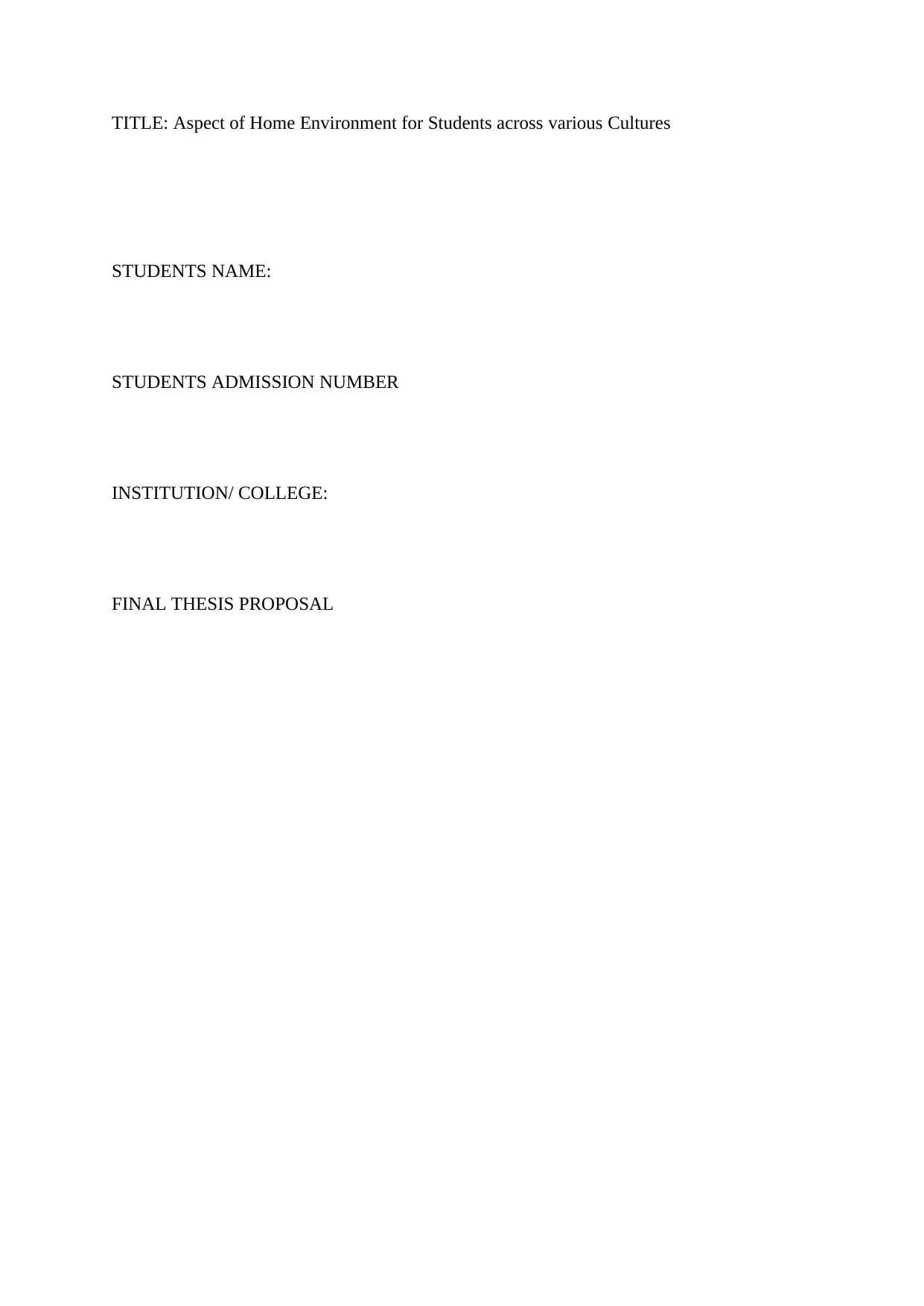
TITLE: Aspect of Home Environment for Students across various Cultures
STUDENTS NAME:
STUDENTS ADMISSION NUMBER
INSTITUTION/ COLLEGE:
FINAL THESIS PROPOSAL
STUDENTS NAME:
STUDENTS ADMISSION NUMBER
INSTITUTION/ COLLEGE:
FINAL THESIS PROPOSAL
Paraphrase This Document
Need a fresh take? Get an instant paraphrase of this document with our AI Paraphraser
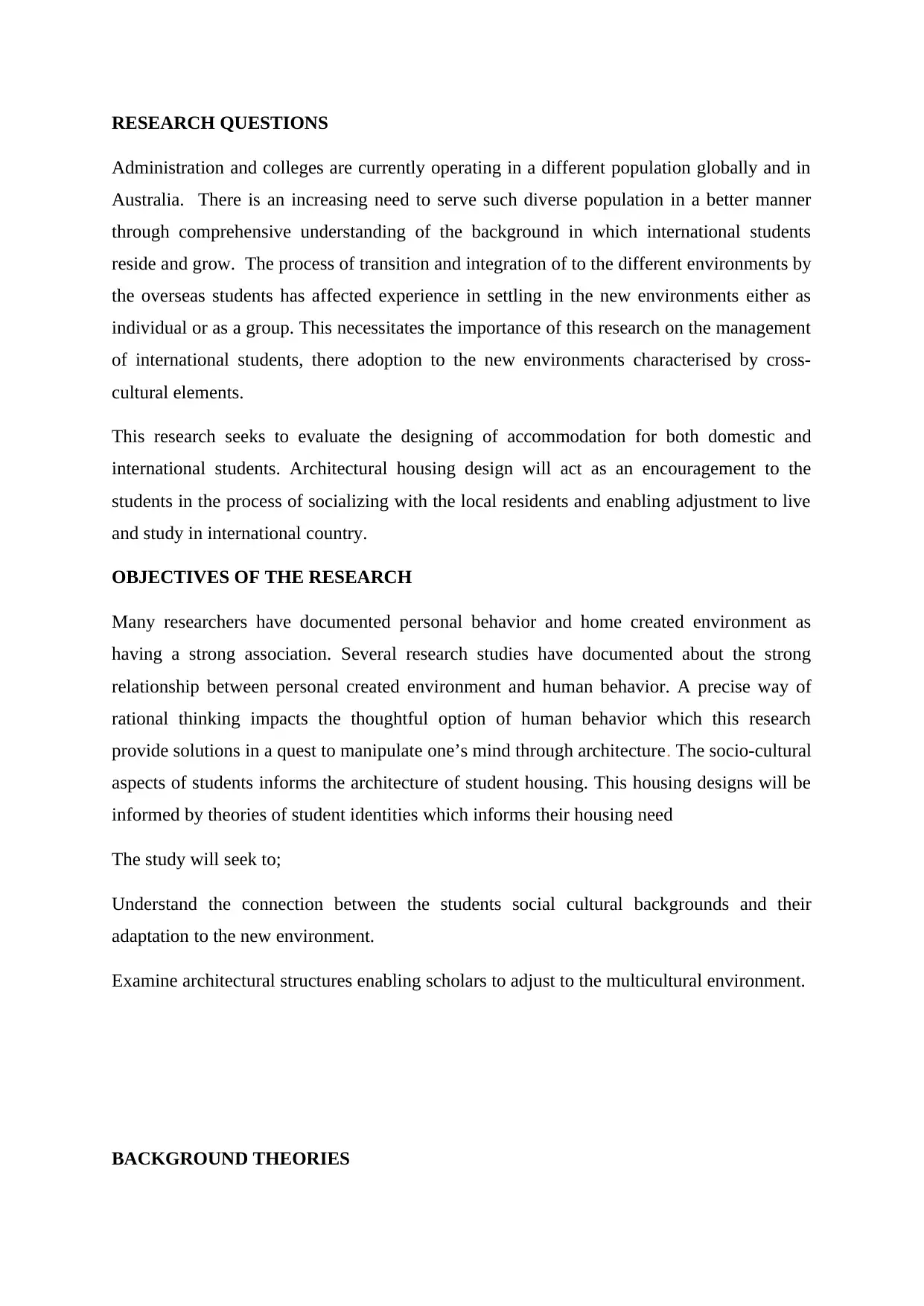
RESEARCH QUESTIONS
Administration and colleges are currently operating in a different population globally and in
Australia. There is an increasing need to serve such diverse population in a better manner
through comprehensive understanding of the background in which international students
reside and grow. The process of transition and integration of to the different environments by
the overseas students has affected experience in settling in the new environments either as
individual or as a group. This necessitates the importance of this research on the management
of international students, there adoption to the new environments characterised by cross-
cultural elements.
This research seeks to evaluate the designing of accommodation for both domestic and
international students. Architectural housing design will act as an encouragement to the
students in the process of socializing with the local residents and enabling adjustment to live
and study in international country.
OBJECTIVES OF THE RESEARCH
Many researchers have documented personal behavior and home created environment as
having a strong association. Several research studies have documented about the strong
relationship between personal created environment and human behavior. A precise way of
rational thinking impacts the thoughtful option of human behavior which this research
provide solutions in a quest to manipulate one’s mind through architecture. The socio-cultural
aspects of students informs the architecture of student housing. This housing designs will be
informed by theories of student identities which informs their housing need
The study will seek to;
Understand the connection between the students social cultural backgrounds and their
adaptation to the new environment.
Examine architectural structures enabling scholars to adjust to the multicultural environment.
BACKGROUND THEORIES
Administration and colleges are currently operating in a different population globally and in
Australia. There is an increasing need to serve such diverse population in a better manner
through comprehensive understanding of the background in which international students
reside and grow. The process of transition and integration of to the different environments by
the overseas students has affected experience in settling in the new environments either as
individual or as a group. This necessitates the importance of this research on the management
of international students, there adoption to the new environments characterised by cross-
cultural elements.
This research seeks to evaluate the designing of accommodation for both domestic and
international students. Architectural housing design will act as an encouragement to the
students in the process of socializing with the local residents and enabling adjustment to live
and study in international country.
OBJECTIVES OF THE RESEARCH
Many researchers have documented personal behavior and home created environment as
having a strong association. Several research studies have documented about the strong
relationship between personal created environment and human behavior. A precise way of
rational thinking impacts the thoughtful option of human behavior which this research
provide solutions in a quest to manipulate one’s mind through architecture. The socio-cultural
aspects of students informs the architecture of student housing. This housing designs will be
informed by theories of student identities which informs their housing need
The study will seek to;
Understand the connection between the students social cultural backgrounds and their
adaptation to the new environment.
Examine architectural structures enabling scholars to adjust to the multicultural environment.
BACKGROUND THEORIES
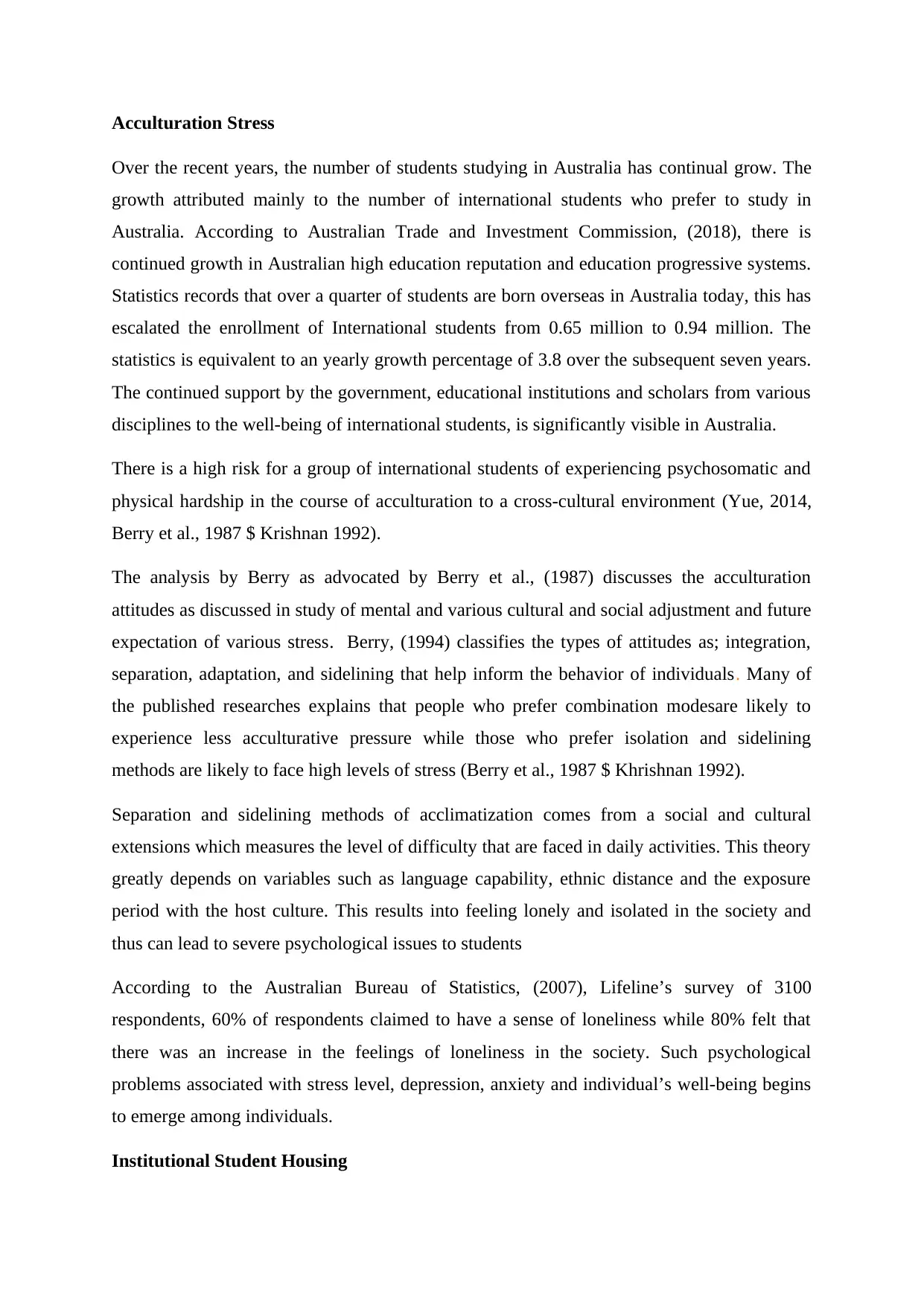
Acculturation Stress
Over the recent years, the number of students studying in Australia has continual grow. The
growth attributed mainly to the number of international students who prefer to study in
Australia. According to Australian Trade and Investment Commission, (2018), there is
continued growth in Australian high education reputation and education progressive systems.
Statistics records that over a quarter of students are born overseas in Australia today, this has
escalated the enrollment of International students from 0.65 million to 0.94 million. The
statistics is equivalent to an yearly growth percentage of 3.8 over the subsequent seven years.
The continued support by the government, educational institutions and scholars from various
disciplines to the well-being of international students, is significantly visible in Australia.
There is a high risk for a group of international students of experiencing psychosomatic and
physical hardship in the course of acculturation to a cross-cultural environment (Yue, 2014,
Berry et al., 1987 $ Krishnan 1992).
The analysis by Berry as advocated by Berry et al., (1987) discusses the acculturation
attitudes as discussed in study of mental and various cultural and social adjustment and future
expectation of various stress. Berry, (1994) classifies the types of attitudes as; integration,
separation, adaptation, and sidelining that help inform the behavior of individuals. Many of
the published researches explains that people who prefer combination modesare likely to
experience less acculturative pressure while those who prefer isolation and sidelining
methods are likely to face high levels of stress (Berry et al., 1987 $ Khrishnan 1992).
Separation and sidelining methods of acclimatization comes from a social and cultural
extensions which measures the level of difficulty that are faced in daily activities. This theory
greatly depends on variables such as language capability, ethnic distance and the exposure
period with the host culture. This results into feeling lonely and isolated in the society and
thus can lead to severe psychological issues to students
According to the Australian Bureau of Statistics, (2007), Lifeline’s survey of 3100
respondents, 60% of respondents claimed to have a sense of loneliness while 80% felt that
there was an increase in the feelings of loneliness in the society. Such psychological
problems associated with stress level, depression, anxiety and individual’s well-being begins
to emerge among individuals.
Institutional Student Housing
Over the recent years, the number of students studying in Australia has continual grow. The
growth attributed mainly to the number of international students who prefer to study in
Australia. According to Australian Trade and Investment Commission, (2018), there is
continued growth in Australian high education reputation and education progressive systems.
Statistics records that over a quarter of students are born overseas in Australia today, this has
escalated the enrollment of International students from 0.65 million to 0.94 million. The
statistics is equivalent to an yearly growth percentage of 3.8 over the subsequent seven years.
The continued support by the government, educational institutions and scholars from various
disciplines to the well-being of international students, is significantly visible in Australia.
There is a high risk for a group of international students of experiencing psychosomatic and
physical hardship in the course of acculturation to a cross-cultural environment (Yue, 2014,
Berry et al., 1987 $ Krishnan 1992).
The analysis by Berry as advocated by Berry et al., (1987) discusses the acculturation
attitudes as discussed in study of mental and various cultural and social adjustment and future
expectation of various stress. Berry, (1994) classifies the types of attitudes as; integration,
separation, adaptation, and sidelining that help inform the behavior of individuals. Many of
the published researches explains that people who prefer combination modesare likely to
experience less acculturative pressure while those who prefer isolation and sidelining
methods are likely to face high levels of stress (Berry et al., 1987 $ Khrishnan 1992).
Separation and sidelining methods of acclimatization comes from a social and cultural
extensions which measures the level of difficulty that are faced in daily activities. This theory
greatly depends on variables such as language capability, ethnic distance and the exposure
period with the host culture. This results into feeling lonely and isolated in the society and
thus can lead to severe psychological issues to students
According to the Australian Bureau of Statistics, (2007), Lifeline’s survey of 3100
respondents, 60% of respondents claimed to have a sense of loneliness while 80% felt that
there was an increase in the feelings of loneliness in the society. Such psychological
problems associated with stress level, depression, anxiety and individual’s well-being begins
to emerge among individuals.
Institutional Student Housing
⊘ This is a preview!⊘
Do you want full access?
Subscribe today to unlock all pages.

Trusted by 1+ million students worldwide
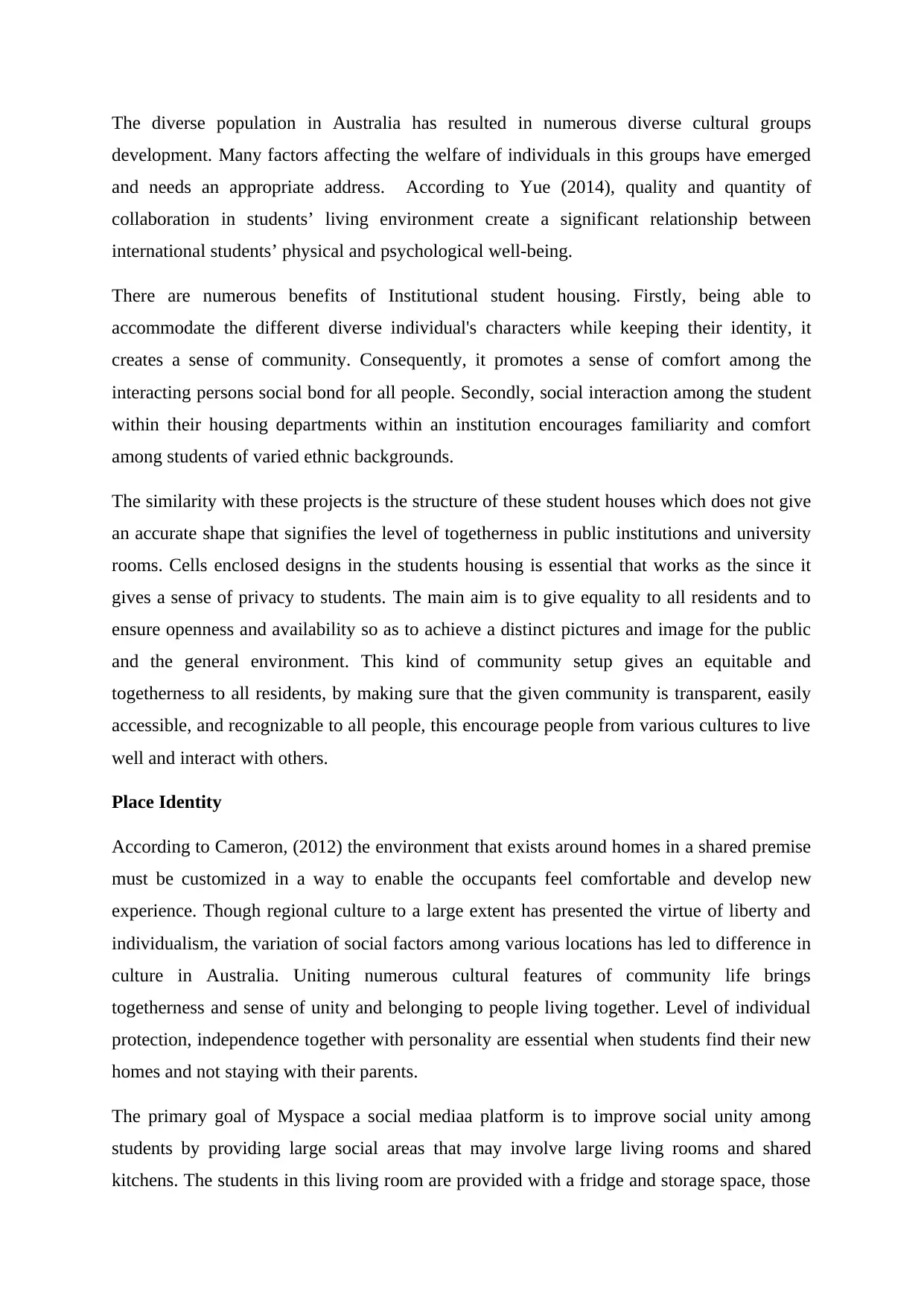
The diverse population in Australia has resulted in numerous diverse cultural groups
development. Many factors affecting the welfare of individuals in this groups have emerged
and needs an appropriate address. According to Yue (2014), quality and quantity of
collaboration in students’ living environment create a significant relationship between
international students’ physical and psychological well-being.
There are numerous benefits of Institutional student housing. Firstly, being able to
accommodate the different diverse individual's characters while keeping their identity, it
creates a sense of community. Consequently, it promotes a sense of comfort among the
interacting persons social bond for all people. Secondly, social interaction among the student
within their housing departments within an institution encourages familiarity and comfort
among students of varied ethnic backgrounds.
The similarity with these projects is the structure of these student houses which does not give
an accurate shape that signifies the level of togetherness in public institutions and university
rooms. Cells enclosed designs in the students housing is essential that works as the since it
gives a sense of privacy to students. The main aim is to give equality to all residents and to
ensure openness and availability so as to achieve a distinct pictures and image for the public
and the general environment. This kind of community setup gives an equitable and
togetherness to all residents, by making sure that the given community is transparent, easily
accessible, and recognizable to all people, this encourage people from various cultures to live
well and interact with others.
Place Identity
According to Cameron, (2012) the environment that exists around homes in a shared premise
must be customized in a way to enable the occupants feel comfortable and develop new
experience. Though regional culture to a large extent has presented the virtue of liberty and
individualism, the variation of social factors among various locations has led to difference in
culture in Australia. Uniting numerous cultural features of community life brings
togetherness and sense of unity and belonging to people living together. Level of individual
protection, independence together with personality are essential when students find their new
homes and not staying with their parents.
The primary goal of Myspace a social mediaa platform is to improve social unity among
students by providing large social areas that may involve large living rooms and shared
kitchens. The students in this living room are provided with a fridge and storage space, those
development. Many factors affecting the welfare of individuals in this groups have emerged
and needs an appropriate address. According to Yue (2014), quality and quantity of
collaboration in students’ living environment create a significant relationship between
international students’ physical and psychological well-being.
There are numerous benefits of Institutional student housing. Firstly, being able to
accommodate the different diverse individual's characters while keeping their identity, it
creates a sense of community. Consequently, it promotes a sense of comfort among the
interacting persons social bond for all people. Secondly, social interaction among the student
within their housing departments within an institution encourages familiarity and comfort
among students of varied ethnic backgrounds.
The similarity with these projects is the structure of these student houses which does not give
an accurate shape that signifies the level of togetherness in public institutions and university
rooms. Cells enclosed designs in the students housing is essential that works as the since it
gives a sense of privacy to students. The main aim is to give equality to all residents and to
ensure openness and availability so as to achieve a distinct pictures and image for the public
and the general environment. This kind of community setup gives an equitable and
togetherness to all residents, by making sure that the given community is transparent, easily
accessible, and recognizable to all people, this encourage people from various cultures to live
well and interact with others.
Place Identity
According to Cameron, (2012) the environment that exists around homes in a shared premise
must be customized in a way to enable the occupants feel comfortable and develop new
experience. Though regional culture to a large extent has presented the virtue of liberty and
individualism, the variation of social factors among various locations has led to difference in
culture in Australia. Uniting numerous cultural features of community life brings
togetherness and sense of unity and belonging to people living together. Level of individual
protection, independence together with personality are essential when students find their new
homes and not staying with their parents.
The primary goal of Myspace a social mediaa platform is to improve social unity among
students by providing large social areas that may involve large living rooms and shared
kitchens. The students in this living room are provided with a fridge and storage space, those
Paraphrase This Document
Need a fresh take? Get an instant paraphrase of this document with our AI Paraphraser
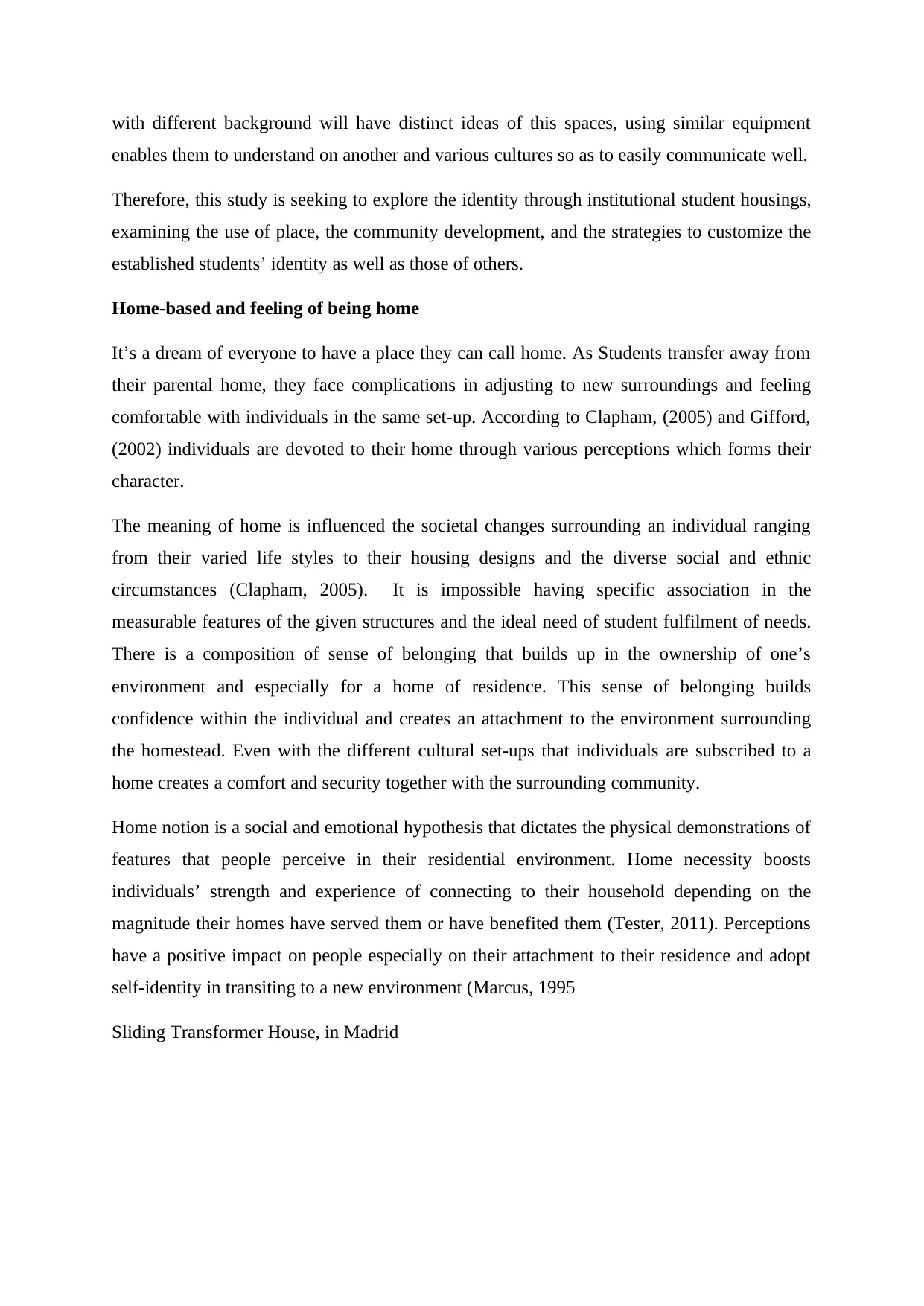
with different background will have distinct ideas of this spaces, using similar equipment
enables them to understand on another and various cultures so as to easily communicate well.
Therefore, this study is seeking to explore the identity through institutional student housings,
examining the use of place, the community development, and the strategies to customize the
established students’ identity as well as those of others.
Home-based and feeling of being home
It’s a dream of everyone to have a place they can call home. As Students transfer away from
their parental home, they face complications in adjusting to new surroundings and feeling
comfortable with individuals in the same set-up. According to Clapham, (2005) and Gifford,
(2002) individuals are devoted to their home through various perceptions which forms their
character.
The meaning of home is influenced the societal changes surrounding an individual ranging
from their varied life styles to their housing designs and the diverse social and ethnic
circumstances (Clapham, 2005). It is impossible having specific association in the
measurable features of the given structures and the ideal need of student fulfilment of needs.
There is a composition of sense of belonging that builds up in the ownership of one’s
environment and especially for a home of residence. This sense of belonging builds
confidence within the individual and creates an attachment to the environment surrounding
the homestead. Even with the different cultural set-ups that individuals are subscribed to a
home creates a comfort and security together with the surrounding community.
Home notion is a social and emotional hypothesis that dictates the physical demonstrations of
features that people perceive in their residential environment. Home necessity boosts
individuals’ strength and experience of connecting to their household depending on the
magnitude their homes have served them or have benefited them (Tester, 2011). Perceptions
have a positive impact on people especially on their attachment to their residence and adopt
self-identity in transiting to a new environment (Marcus, 1995
Sliding Transformer House, in Madrid
enables them to understand on another and various cultures so as to easily communicate well.
Therefore, this study is seeking to explore the identity through institutional student housings,
examining the use of place, the community development, and the strategies to customize the
established students’ identity as well as those of others.
Home-based and feeling of being home
It’s a dream of everyone to have a place they can call home. As Students transfer away from
their parental home, they face complications in adjusting to new surroundings and feeling
comfortable with individuals in the same set-up. According to Clapham, (2005) and Gifford,
(2002) individuals are devoted to their home through various perceptions which forms their
character.
The meaning of home is influenced the societal changes surrounding an individual ranging
from their varied life styles to their housing designs and the diverse social and ethnic
circumstances (Clapham, 2005). It is impossible having specific association in the
measurable features of the given structures and the ideal need of student fulfilment of needs.
There is a composition of sense of belonging that builds up in the ownership of one’s
environment and especially for a home of residence. This sense of belonging builds
confidence within the individual and creates an attachment to the environment surrounding
the homestead. Even with the different cultural set-ups that individuals are subscribed to a
home creates a comfort and security together with the surrounding community.
Home notion is a social and emotional hypothesis that dictates the physical demonstrations of
features that people perceive in their residential environment. Home necessity boosts
individuals’ strength and experience of connecting to their household depending on the
magnitude their homes have served them or have benefited them (Tester, 2011). Perceptions
have a positive impact on people especially on their attachment to their residence and adopt
self-identity in transiting to a new environment (Marcus, 1995
Sliding Transformer House, in Madrid
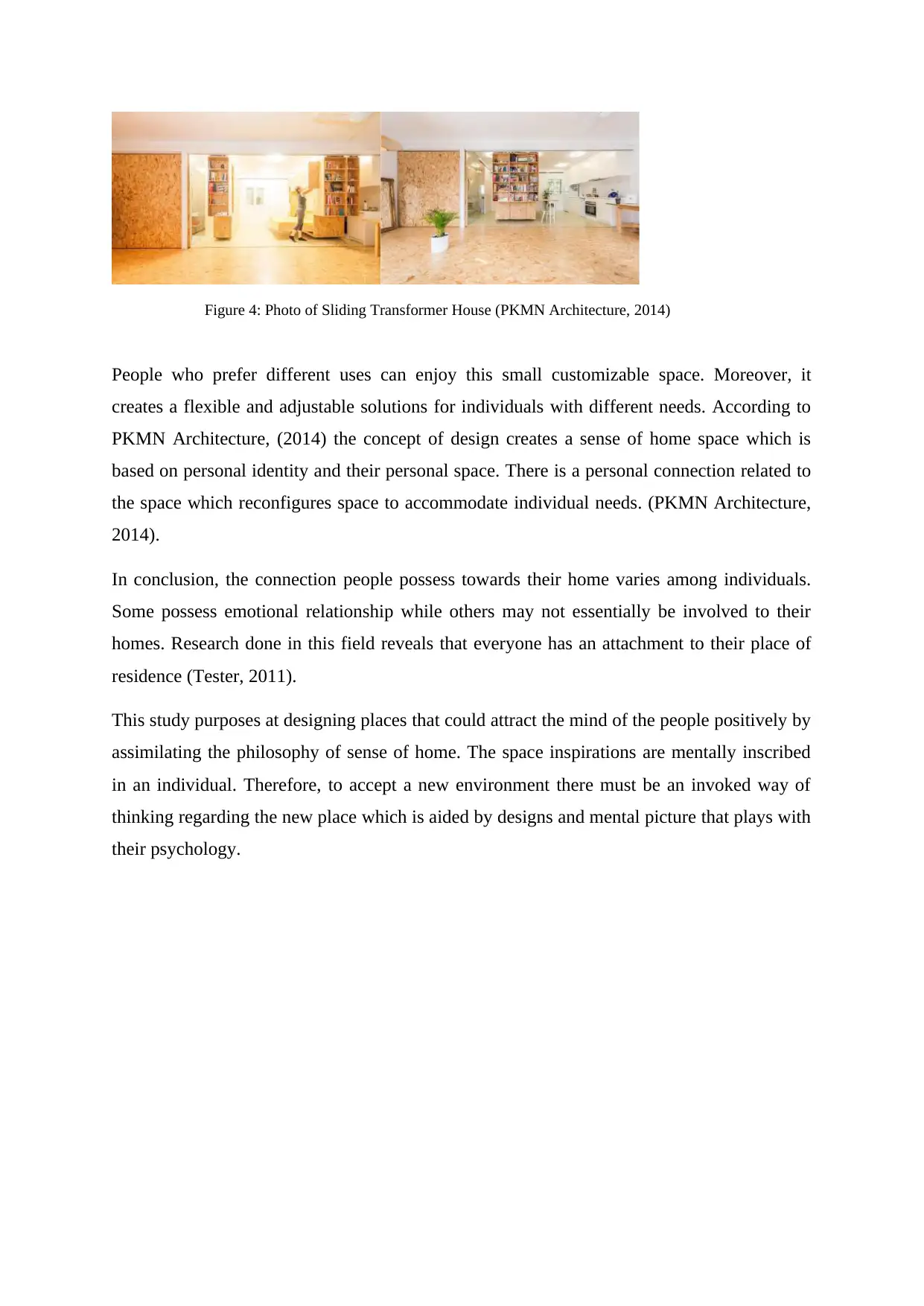
People who prefer different uses can enjoy this small customizable space. Moreover, it
creates a flexible and adjustable solutions for individuals with different needs. According to
PKMN Architecture, (2014) the concept of design creates a sense of home space which is
based on personal identity and their personal space. There is a personal connection related to
the space which reconfigures space to accommodate individual needs. (PKMN Architecture,
2014).
In conclusion, the connection people possess towards their home varies among individuals.
Some possess emotional relationship while others may not essentially be involved to their
homes. Research done in this field reveals that everyone has an attachment to their place of
residence (Tester, 2011).
This study purposes at designing places that could attract the mind of the people positively by
assimilating the philosophy of sense of home. The space inspirations are mentally inscribed
in an individual. Therefore, to accept a new environment there must be an invoked way of
thinking regarding the new place which is aided by designs and mental picture that plays with
their psychology.
Figure 4: Photo of Sliding Transformer House (PKMN Architecture, 2014)
creates a flexible and adjustable solutions for individuals with different needs. According to
PKMN Architecture, (2014) the concept of design creates a sense of home space which is
based on personal identity and their personal space. There is a personal connection related to
the space which reconfigures space to accommodate individual needs. (PKMN Architecture,
2014).
In conclusion, the connection people possess towards their home varies among individuals.
Some possess emotional relationship while others may not essentially be involved to their
homes. Research done in this field reveals that everyone has an attachment to their place of
residence (Tester, 2011).
This study purposes at designing places that could attract the mind of the people positively by
assimilating the philosophy of sense of home. The space inspirations are mentally inscribed
in an individual. Therefore, to accept a new environment there must be an invoked way of
thinking regarding the new place which is aided by designs and mental picture that plays with
their psychology.
Figure 4: Photo of Sliding Transformer House (PKMN Architecture, 2014)
⊘ This is a preview!⊘
Do you want full access?
Subscribe today to unlock all pages.

Trusted by 1+ million students worldwide
1 out of 6
Related Documents
Your All-in-One AI-Powered Toolkit for Academic Success.
+13062052269
info@desklib.com
Available 24*7 on WhatsApp / Email
![[object Object]](/_next/static/media/star-bottom.7253800d.svg)
Unlock your academic potential
Copyright © 2020–2025 A2Z Services. All Rights Reserved. Developed and managed by ZUCOL.





